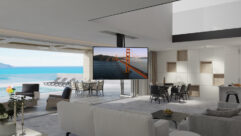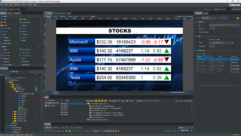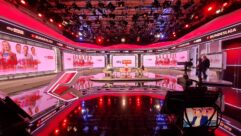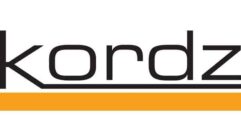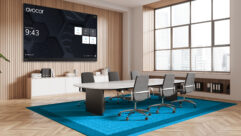
The Buzz: Installation Spotlight:
Ball Aerospace, Boulder and Broomfield, Colo.
Nov 1, 2006 12:00 PM,
By Trevor Boyer
Space Campus
Ball Aerospace and Technologies has designed components for many groundbreaking high-tech NASA projects, such as the Hubble Space Telescope, for which the company built seven instruments. Though its day-to-day work pushes the technology envelope, in its corporate AV systems the government contractor is generally more concerned with adopting reliable, useful technology than staying ahead of the curve with the latest and greatest.

In the Flatirons room in Broomfield, Colo., one Christie LX25 projector is dedicated to displaying the far end of the conference on a Smart board. And the main projector, shining on a Draper 8’x6’ Access V screen, shows local spreadsheets and PowerPoint presentations. that are simultaneously being sent to the far end via the Polycom.
Over the past year, Ball has undergone an upgrade of the display systems in 70 of its conference rooms. Matrix Display Systems of Boulder, Colo., has installed new XGA-resolution Christie projectors in the conference rooms and in meeting rooms at both the Boulder campus of Ball Aerospace and at its corporate headquarters in Broomfield, Colo.
Matrix Display Systems helped Ball Aerospace switch to Christie projectors at the end of a lease cycle on older projectors. “At the time Ball had chosen Sharp projectors, technology was changing so quickly that it made more sense to lease than buy,” says Matt Zavakos, president of Matrix. At this point, however, projector technology has reached somewhat of a plateau — XGA resolution is something of a standard for data projection. So at Matrix’s recommendation, Ball Aerospace chose Christie DS+60, DS+65, LX32, and LX32 projectors.
At the Boulder campus Matrix outfitted about 70 conference rooms, which are by and large based on a single template. A “Ball conference room,” as Zavakos describes it, includes a manual-pulldown Draper screen; a Christie LX32 or LX25 projector mounted to the ceiling via Chief hardware; an Extron P/2 DA2 one-input, two-output distribution amplifier; and a custom wall plate.
The rooms are used for day-to-day work functions such as training and collaboration. “Thirty-four hundred lumens is plenty bright for these little conference rooms,” Zavakos says, “and XGA is pretty much what they need. Most of the time what they’re presenting is PowerPoint presentations.”
Though the focus is on data projection, video is also a consideration. The rooms accommodate a DVD/VHS combo; the Boulder location has a campuswide RF system that lets employees watch launches on NASA TV from any location. Employees gather for special events, some of them occurring in outer space. In 2005, for example, NASA’s Deep Impact craft released a smaller spacecraft that intercepted the path of the comet Tempel 1 and gathered photos of the collision. “Deep Impact occurred in the wee hours — the place was full,” Zavakos says.
Matrix Display Systems performed the switchovers to the Christie projectors “in piecemeal fashion” starting in October 2005, Zavakos says.
Matrix is a three-year-old company, but Zavakos had a relationship with Ball in a previous position. The company became a Christie dealer upon its inception — the company’s philosophy is to develop relationships with a single manufacturer for each major installation component. (For instance, Matrix also exclusively sells Draper, Extron, and AMX products.)
Ball Aerospace has also hired Matrix Display Systems to upgrade an “all-hands” room at its Boulder campus, designed for larger meetings.
“With the new all-hands room, HD content is more important,” Zavakos says. The room seats 300 and will feature three Christie DS+65 projectors at the front of house. These projectors, though still natively 4:3 at 1400×1050 resolution (SXGA+), have more pixels to work with than Christie’s LX series. The DS+65 projectors are also quite a bit brighter at 6500 ANSI lumens.
The three units fill a wide-aspect ratio screen, a legacy element of the meeting room. The outside two DS+65s fill up the screen in a left-right configuration, and the center projector is used in the case of a single-slide presentation. The outside projectors are used in dual-head multimedia presentations. The two images are from separate sources, and at this point there are no plans to integrate the two via a videowall processor. The images are fed through an Extron 16×16 router (1616HVA RGBHV with audio), so that any source can be routed easily to any projector. The room is long and narrow, so there are two Christie LX32 projectors about halfway to two-thirds of the way back in the room that duplicate the main presentations to aid with sightline issues, according to Zavakos.
The all-hands room also has a full audio system, with 24 JBL C26 ceiling speakers, three Crown CTS8200 amplifiers, an Audio-Technica gooseneck mic at the podium, and a Lectrosonics wireless audio system that includes three UDR700 receivers, two UM700 belt-pack transmitters with CountryMan B6 mics, and a UT700VM handheld transmitter.
Matrix Display Systems has also installed a Lectrosonics mix-minus teleconferencing system in the corporate boardroom at the Broomfield campus.This system, along with a Polycom VSX7000 videoconferencing codec, allows participants in the Flatirons conference room, the executive area at corporate headquarters, to communicate with Ball’s Washington, D.C. office. Ball also plans to expand its legacy standalone videoconference room on the Boulder campus.
Through the Polycom People+Content feature, teams can share data via their videoconferencing systems. In the Flatirons room in Broomfield, one Christie LX25 projector is dedicated to displaying the far end of the conference (the other location) on a Smart board. And the main projector, shining on a Draper 8’×6′ Access V screen, shows local spreadsheets and PowerPoint presentations that are simultaneously being sent to the far end via the Polycom.
Right now the Christie projectors, so numerous across the Boulder and Broomfield campuses, are islands, but Ball Aerospace has expressed interest in networking them. At this point, checking the status of the conference room gear and maintaining it is a labor-intensive task for Ball. “They really have to dedicate a large portion of somebody’s time to walk around and check them out,” says Zavakos. ChristieNET hardware networking devices are standard on newer projectors such as the DS+65, but the LX series units will require an external ChristieNET box.
SUBSCRIBE TO SOUND & VIDEO CONTRACTOR E-NEWSLETTERS!
Sound & Video Contractor EXTRA
Systems Integration Special Focus series:
- Houses of Worship
- Corporate AV
- Residential AV
- AV Over Fiber
- AV in Education
Breaking industry news in your email inbox every other week!
Subscribe atwww.svconline.com


